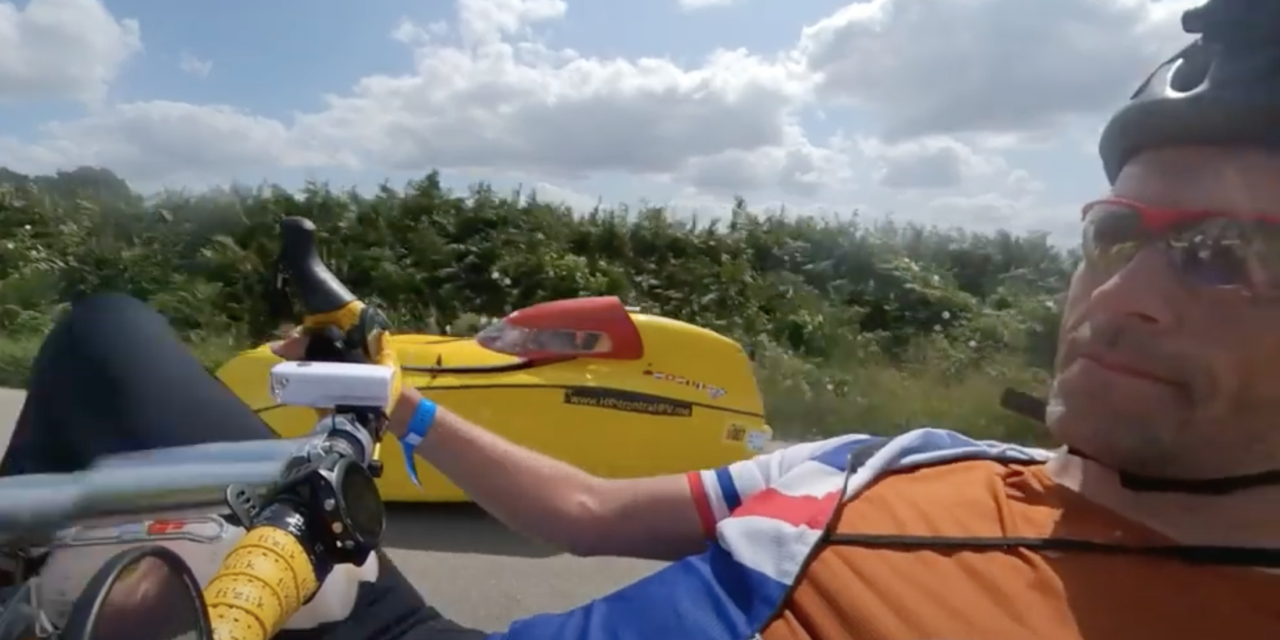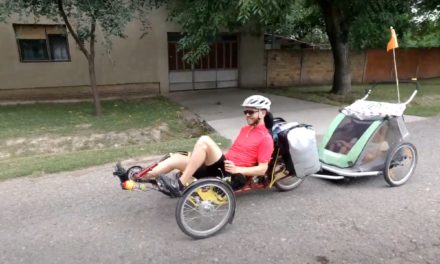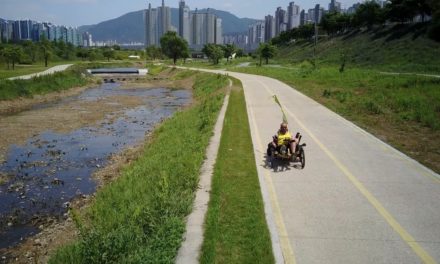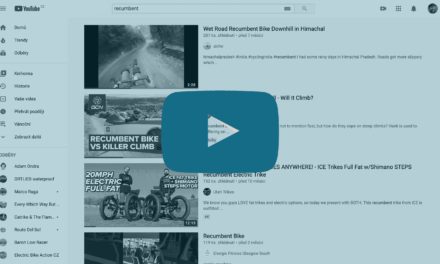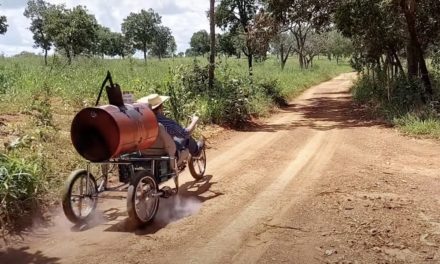Paris–Brest–Paris (PBP) is a long-distance cycling event known as a brevet or randonnée. It was originally a 1,200 km / 750 mi bike race from Paris to Brest and back to Paris. It was first organized in 1891 and the last time it was run as a race was 1951. It is held every four years and the goal is to make it within 90 hours, but with no competition.
It is a self-supported event where riders need to purchase any supplies needed locally or just use the check-points where some meals are provided as well. At the check-points, it is possible to have some sleep, but riders sleep very little and often just take a short nap next to the road.
To be able to participate in PBP you have to finish 200, 300, 400, and 600 km long brevets before the PBP which is a challenge by itself. There are many recumbent two-wheelers, trikes, velomobiles and their riders present every time it is ridden.
I am not a big fan of long videos taken just from the bike itself without actually seeing the rider riding, but this one from Tor caught my attention. Thanks to the 360° camera and all the information provided, it is very enjoyable and just enough long. I asked Tor several questions and his answers are very enjoyable and interesting as well.
Was that your first PBP?
Yes, 2019 was my first PBP.
How long have you been riding recumbents?
In 2009, I ordered a Bacchetta Giro 26 from Perennial Cycle in the USA. At the time, I was mostly into mountain biking, and was not doing any long-distance cycling yet. I used the Bacchetta on the occasional Sunday ride, and I also did a little touring on it.
While the Bacchetta is very comfortable and also quite efficient on the flats, in Norway where I live, it usually isn’t flat for long stretches at a time, and I started looking into recumbents that are great for climbing, such as the Lightning P-38 and the MetaBike. Then I read about Cruzbike and the direct power connection between handlebar and crank, enabling the upper body to assist when climbing or otherwise pushing hard, and it made a lot of sense to me. As it happened, Peder Torgersen at Sykkel-Bent here in Norway had a Cruzbike Vendetta for me to rent during my summer vacation on the south coast. It was a little hard to get used to the movable bottom bracket, and I have a couple of YouTube videos where I’m learning to ride it, but in a matter of days, I was going for long rides. During those weeks, I did my longest ride so far of 200 km, and as I was passing some people on a steep climb, one of them shouted “That is the coolest bike I have ever seen!”
I didn’t buy a Cruzbike that year. I still wasn’t sure that I would ride it as much as it deserved to.
What is your motivation to do such a ride and rides before as well?
In Norway, recumbents have not been allowed to take part in races since 1997, when Bram Moens, the founder of M5, finished the 543 km long race from Trondheim to Oslo 1,5 hours ahead of the fastest non-recumbent rider. The rules were changed mid-race, and recumbents have been banned since. Although this has finally changed, and I have received confirmation from the race organization as well as from the national cycling association that recumbents are welcome to race again. I’m looking forward to actually doing that next season.
But as I couldn’t race on the Bacchetta, I started looking into alternatives, and that’s how I learned about randonneuring, audax cycling, and brevets. There was also this book called “Bike for Life”, by Wallack and Katovsky, that mentioned Paris-Brest-Paris a lot. As the world’s oldest cycling event that is still held, it is like the Olympics for long-distance cyclists. “For 5,000-plus endurance riders who show up in Paris every four years, a P-B-P finish is like graduating from Harvard.”
I fantasized about doing PBP for many years, but I never believed I was capable of completing such distances. Until May 2018, when I decided I would give it a shot and see if I could complete the local 400 km brevet on the Bacchetta. I was the sole participant. I wasn’t fast, I got both knee and ankle pain, and I was terribly tired through the night, but I completed the ride in 23,5 hours.
I took this as an encouragement to train for a PBP qualification series, and PBP itself, the following season. I also took it as a justification to finally buy a Cruzbike Vendetta. I found a used one in France, previously owned by recumbent ultra-cyclist and PBP finisher Marcel Flaux.
The following qualification brevets went well, all of them still solo. The 300 was by far the most challenging, with constant rain and a solid helping of sleet and snow. I brought an extra pair of winter gloves, but when they’re soaking wet they still get ice cold. I had numb fingertips for months after that. The 400 was much nicer, and I improved my time by more than 4 hours. Both the 400 and 600 are on my YouTube channel.
As it happened, it was lucky I did that 400 in 2018. PBP is getting even more popular, and in 2019 there wasn’t room for all who qualified. Those who had completed long brevets the year before were allowed to pre-register, and that is how I secured my spot.
Where do you see their biggest advantage over upright bikes when riding such brevets?
The number one advantage is comfort. I can honestly say that I rode the 1200 km in France with no discomfort to speak of. Needless to say, many, if not most, participants struggle with pain in the back, neck, shoulders, arms, hands, or of course, the saddle area. On a recumbent, all of this is mostly a non-issue, but you can still get knee and ankle pain if the fit isn’t right or if you’re not used to riding long distances. And your back may want to have a short break from time to time, a bit like when you’re doing a long trip by car.
The second advantage is aero. On PBP it felt as if I had a constant benefit of drafting, even if nobody was in front. I could certainly benefit from holding on to a paceline, but very often I would just swing out and ride alongside them, seemingly as easily, or even pass them. It has to be said that if I was riding with the faster groups that started before me, just trying to hang on would have been substantially more challenging.
Which part of France did you like most during the ride?
I enjoyed the whole route. What really separates PBP from any other event is the support from the locals. They were cheering us on all the way, sometimes even in the middle of the night. I also enjoyed the constant stream of small villages that we passed through. Some of the highlights were the volunteer coffee stand by Laurie Renard and family at Hardanges, as well as the few cafe stops I found time for.
Unfortunately, I only got to see Brest at night-time, and the same is true for the control at Villaines-la-Juhel, which is supposed to be full of life during the day, but there was not much going on when I passed it during the first night as well as very early in the morning on the final day.
What was the worst time for you on PBP?
Honestly, I didn’t have any serious downs, but I felt a little lost on the final few kilometers before Brest. It was completely dark, my headlamp wasn’t great, and there were actually a few other riders around at that point. It was also disappointing to not get a mattress in Brest, particularly as the last few were handed to the two guys that jumped the queue ahead of me. And it was really tough being woken up in Fougères after two hours of sleep, with 300 km to go. I was like a zombie until the sun rose several hours later that morning.
How many hours did it take for you to finish and how many hours did you sleep?
I finished the ride in 72 hours and 20 minutes. I was moving for 50 hours and 40 minutes. I had 3 hours sleep in Brest, 2 hours in Fougères, 20 minutes at Loudéac on each visit, and a 20 minute and a 10-minute power nap on the final day. That should total a little over 6 hours of sleep. I also took time for a shower and a change of clothes in Brest. The rest of the time was distributed over 20 controls and food stops along the way.
Do you know, how many recumbents, trikes and velomobiles participated?
All recumbents ride in start group F, along with velomobiles, trikes, tandems, Concours de Machines participants, and any other unusual bicycles. That group had 220 participants. 78 of those rode tandems, 3 German brothers rode a triplet, 6 rode trikes, and 131 rode “special” bikes, which includes recumbents and velomobiles.
Oh, and the fastest finisher overall was Hajo Eckstein in his DF velomobile, completing the ride in 43:49:47.
There are a few YouTube videos that show the departure of this start group:
https://www.youtube.com/watch?v=ekW1PZg6LO8
https://www.youtube.com/watch?v=5nWxgf0Uaro
Paris-Brest-Paris Bulge Chart from Jo Wood on Vimeo.

